engine coolant CADILLAC CTS 2009 2.G Owners Manual
[x] Cancel search | Manufacturer: CADILLAC, Model Year: 2009, Model line: CTS, Model: CADILLAC CTS 2009 2.GPages: 490, PDF Size: 2.68 MB
Page 5 of 490
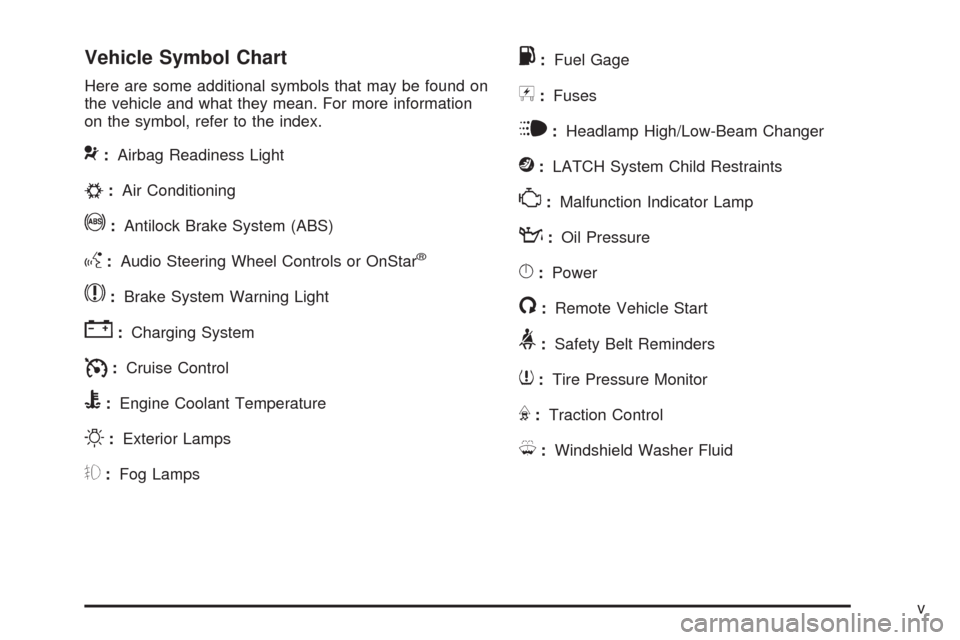
Vehicle Symbol Chart
Here are some additional symbols that may be found on
the vehicle and what they mean. For more information
on the symbol, refer to the index.
9:Airbag Readiness Light
#:Air Conditioning
!:Antilock Brake System (ABS)
g:Audio Steering Wheel Controls or OnStar®
$:Brake System Warning Light
":Charging System
I:Cruise Control
B:Engine Coolant Temperature
O:Exterior Lamps
#:Fog Lamps
.:Fuel Gage
+:Fuses
i:Headlamp High/Low-Beam Changer
j:LATCH System Child Restraints
*:Malfunction Indicator Lamp
::Oil Pressure
}:Power
/:Remote Vehicle Start
>:Safety Belt Reminders
7:Tire Pressure Monitor
F:Traction Control
M:Windshield Washer Fluid
v
Page 83 of 490
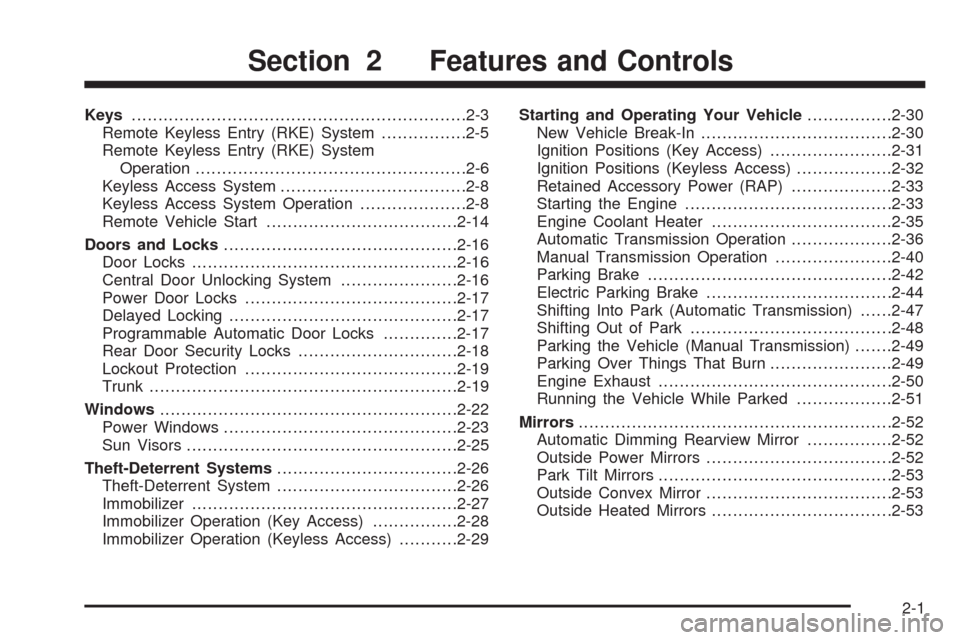
Keys...............................................................2-3
Remote Keyless Entry (RKE) System................2-5
Remote Keyless Entry (RKE) System
Operation...................................................2-6
Keyless Access System...................................2-8
Keyless Access System Operation....................2-8
Remote Vehicle Start....................................2-14
Doors and Locks............................................2-16
Door Locks..................................................2-16
Central Door Unlocking System......................2-16
Power Door Locks........................................2-17
Delayed Locking...........................................2-17
Programmable Automatic Door Locks..............2-17
Rear Door Security Locks..............................2-18
Lockout Protection........................................2-19
Trunk..........................................................2-19
Windows........................................................2-22
Power Windows............................................2-23
Sun Visors...................................................2-25
Theft-Deterrent Systems..................................2-26
Theft-Deterrent System..................................2-26
Immobilizer..................................................2-27
Immobilizer Operation (Key Access)................2-28
Immobilizer Operation (Keyless Access)...........2-29Starting and Operating Your Vehicle................2-30
New Vehicle Break-In....................................2-30
Ignition Positions (Key Access).......................2-31
Ignition Positions (Keyless Access)..................2-32
Retained Accessory Power (RAP)...................2-33
Starting the Engine.......................................2-33
Engine Coolant Heater..................................2-35
Automatic Transmission Operation...................2-36
Manual Transmission Operation......................2-40
Parking Brake..............................................2-42
Electric Parking Brake
...................................2-44
Shifting Into Park (Automatic Transmission)......2-47
Shifting Out of Park......................................2-48
Parking the Vehicle (Manual Transmission).......2-49
Parking Over Things That Burn.......................2-49
Engine Exhaust............................................2-50
Running the Vehicle While Parked..................2-51
Mirrors...........................................................2-52
Automatic Dimming Rearview Mirror................2-52
Outside Power Mirrors...................................2-52
Park Tilt Mirrors............................................2-53
Outside Convex Mirror...................................2-53
Outside Heated Mirrors..................................2-53
Section 2 Features and Controls
2-1
Page 97 of 490
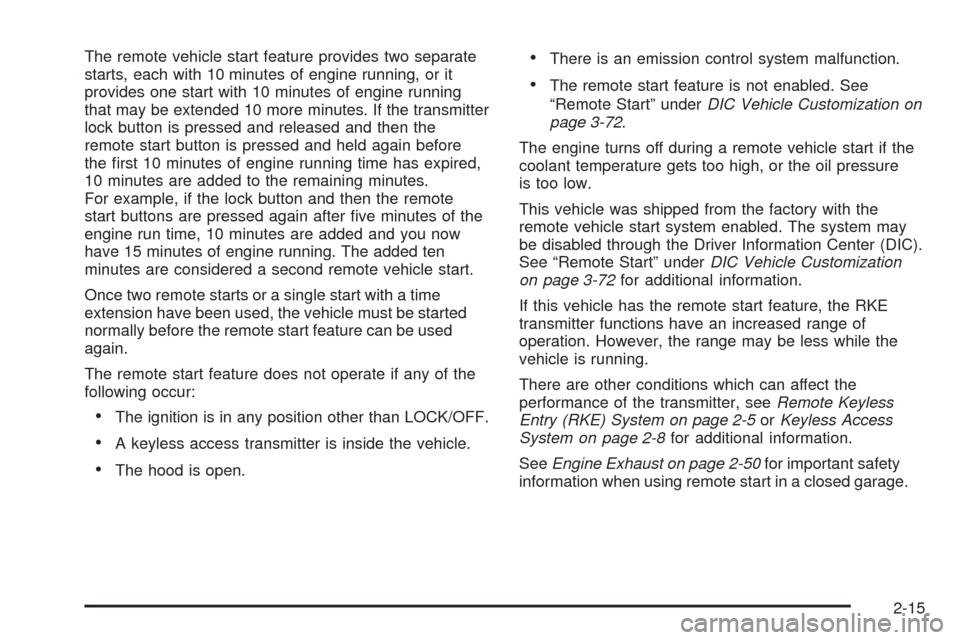
The remote vehicle start feature provides two separate
starts, each with 10 minutes of engine running, or it
provides one start with 10 minutes of engine running
that may be extended 10 more minutes. If the transmitter
lock button is pressed and released and then the
remote start button is pressed and held again before
the �rst 10 minutes of engine running time has expired,
10 minutes are added to the remaining minutes.
For example, if the lock button and then the remote
start buttons are pressed again after �ve minutes of the
engine run time, 10 minutes are added and you now
have 15 minutes of engine running. The added ten
minutes are considered a second remote vehicle start.
Once two remote starts or a single start with a time
extension have been used, the vehicle must be started
normally before the remote start feature can be used
again.
The remote start feature does not operate if any of the
following occur:
The ignition is in any position other than LOCK/OFF.
A keyless access transmitter is inside the vehicle.
The hood is open.
There is an emission control system malfunction.
The remote start feature is not enabled. See
“Remote Start” underDIC Vehicle Customization on
page 3-72.
The engine turns off during a remote vehicle start if the
coolant temperature gets too high, or the oil pressure
is too low.
This vehicle was shipped from the factory with the
remote vehicle start system enabled. The system may
be disabled through the Driver Information Center (DIC).
See “Remote Start” underDIC Vehicle Customization
on page 3-72for additional information.
If this vehicle has the remote start feature, the RKE
transmitter functions have an increased range of
operation. However, the range may be less while the
vehicle is running.
There are other conditions which can affect the
performance of the transmitter, seeRemote Keyless
Entry (RKE) System on page 2-5orKeyless Access
System on page 2-8for additional information.
SeeEngine Exhaust on page 2-50for important safety
information when using remote start in a closed garage.
2-15
Page 117 of 490
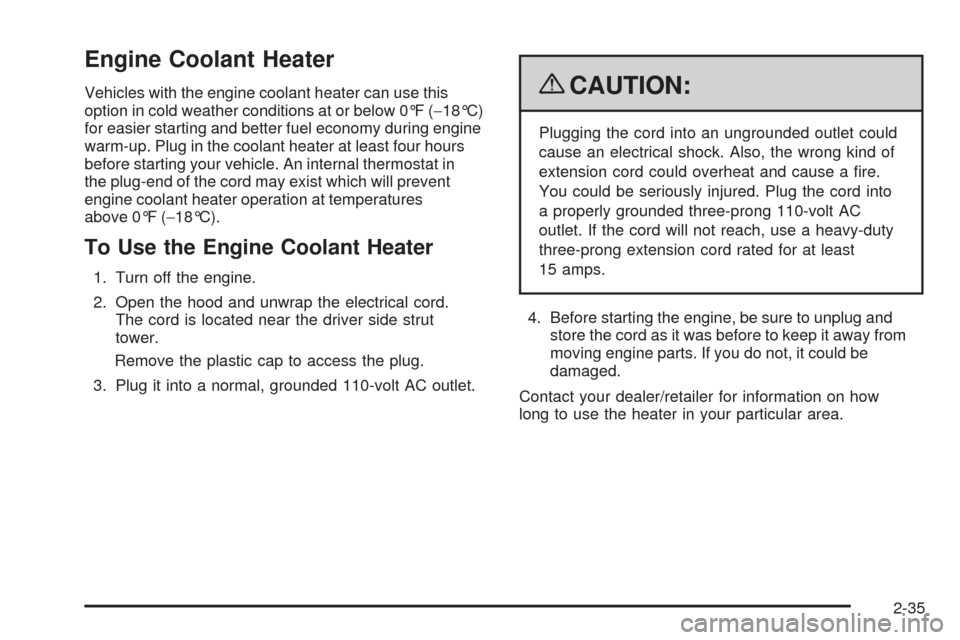
Engine Coolant Heater
Vehicles with the engine coolant heater can use this
option in cold weather conditions at or below 0°F (−18°C)
for easier starting and better fuel economy during engine
warm-up. Plug in the coolant heater at least four hours
before starting your vehicle. An internal thermostat in
the plug-end of the cord may exist which will prevent
engine coolant heater operation at temperatures
above 0°F (−18°C).
To Use the Engine Coolant Heater
1. Turn off the engine.
2. Open the hood and unwrap the electrical cord.
The cord is located near the driver side strut
tower.
Remove the plastic cap to access the plug.
3. Plug it into a normal, grounded 110-volt AC outlet.
{CAUTION:
Plugging the cord into an ungrounded outlet could
cause an electrical shock. Also, the wrong kind of
extension cord could overheat and cause a �re.
You could be seriously injured. Plug the cord into
a properly grounded three-prong 110-volt AC
outlet. If the cord will not reach, use a heavy-duty
three-prong extension cord rated for at least
15 amps.
4. Before starting the engine, be sure to unplug and
store the cord as it was before to keep it away from
moving engine parts. If you do not, it could be
damaged.
Contact your dealer/retailer for information on how
long to use the heater in your particular area.
2-35
Page 149 of 490
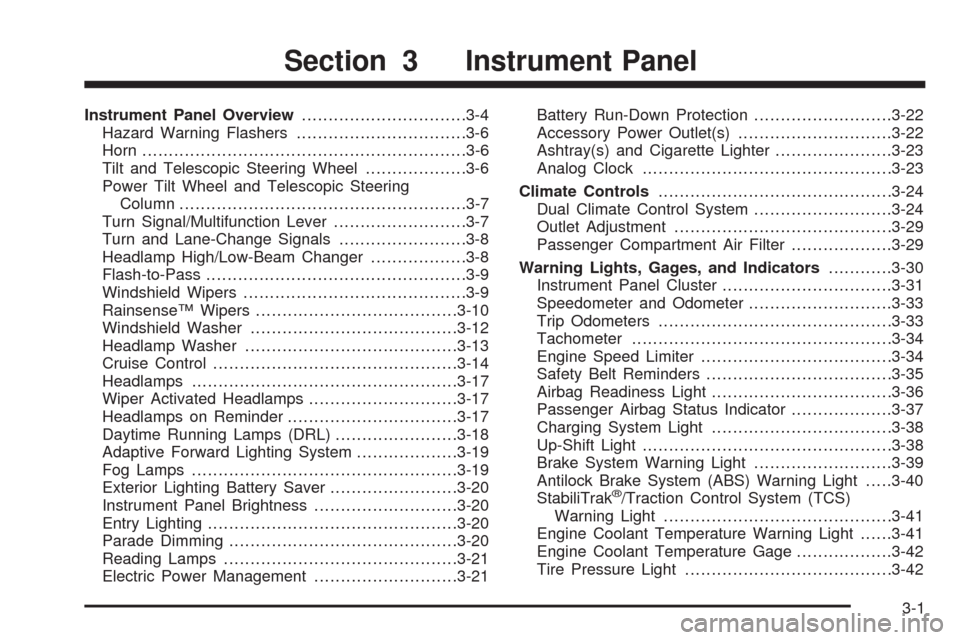
Instrument Panel Overview...............................3-4
Hazard Warning Flashers................................3-6
Horn .............................................................3-6
Tilt and Telescopic Steering Wheel...................3-6
Power Tilt Wheel and Telescopic Steering
Column......................................................3-7
Turn Signal/Multifunction Lever.........................3-7
Turn and Lane-Change Signals........................3-8
Headlamp High/Low-Beam Changer..................3-8
Flash-to-Pass.................................................3-9
Windshield Wipers..........................................3-9
Rainsense™ Wipers......................................3-10
Windshield Washer.......................................3-12
Headlamp Washer........................................3-13
Cruise Control..............................................3-14
Headlamps..................................................3-17
Wiper Activated Headlamps............................3-17
Headlamps on Reminder................................3-17
Daytime Running Lamps (DRL).......................3-18
Adaptive Forward Lighting System...................3-19
Fog Lamps ..................................................3-19
Exterior Lighting Battery Saver........................3-20
Instrument Panel Brightness...........................3-20
Entry Lighting...............................................3-20
Parade Dimming...........................................3-20
Reading Lamps............................................3-21
Electric Power Management...........................3-21Battery Run-Down Protection..........................3-22
Accessory Power Outlet(s).............................3-22
Ashtray(s) and Cigarette Lighter......................3-23
Analog Clock...............................................3-23
Climate Controls............................................3-24
Dual Climate Control System..........................3-24
Outlet Adjustment.........................................3-29
Passenger Compartment Air Filter...................3-29
Warning Lights, Gages, and Indicators............3-30
Instrument Panel Cluster................................3-31
Speedometer and Odometer...........................3-33
Trip Odometers............................................3-33
Tachometer.................................................3-34
Engine Speed Limiter....................................3-34
Safety Belt Reminders...................................3-35
Airbag Readiness Light..................................3-36
Passenger Airbag Status Indicator...................3-37
Charging System Light..................................3-38
Up-Shift Light...............................................3-38
Brake System Warning Light..........................3-39
Antilock Brake System (ABS) Warning Light.....3-40
StabiliTrak
®/Traction Control System (TCS)
Warning Light...........................................3-41
Engine Coolant Temperature Warning Light......3-41
Engine Coolant Temperature Gage..................3-42
Tire Pressure Light.......................................3-42
Section 3 Instrument Panel
3-1
Page 189 of 490
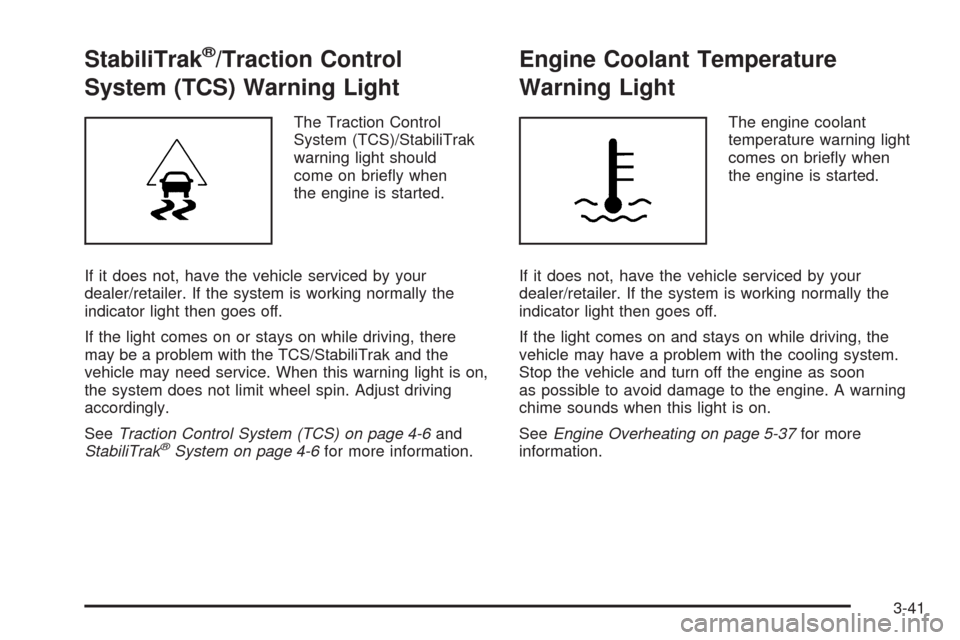
StabiliTrak®/Traction Control
System (TCS) Warning Light
The Traction Control
System (TCS)/StabiliTrak
warning light should
come on brie�y when
the engine is started.
If it does not, have the vehicle serviced by your
dealer/retailer. If the system is working normally the
indicator light then goes off.
If the light comes on or stays on while driving, there
may be a problem with the TCS/StabiliTrak and the
vehicle may need service. When this warning light is on,
the system does not limit wheel spin. Adjust driving
accordingly.
SeeTraction Control System (TCS) on page 4-6and
StabiliTrak
®System on page 4-6for more information.
Engine Coolant Temperature
Warning Light
The engine coolant
temperature warning light
comes on brie�y when
the engine is started.
If it does not, have the vehicle serviced by your
dealer/retailer. If the system is working normally the
indicator light then goes off.
If the light comes on and stays on while driving, the
vehicle may have a problem with the cooling system.
Stop the vehicle and turn off the engine as soon
as possible to avoid damage to the engine. A warning
chime sounds when this light is on.
SeeEngine Overheating on page 5-37for more
information.
3-41
Page 190 of 490
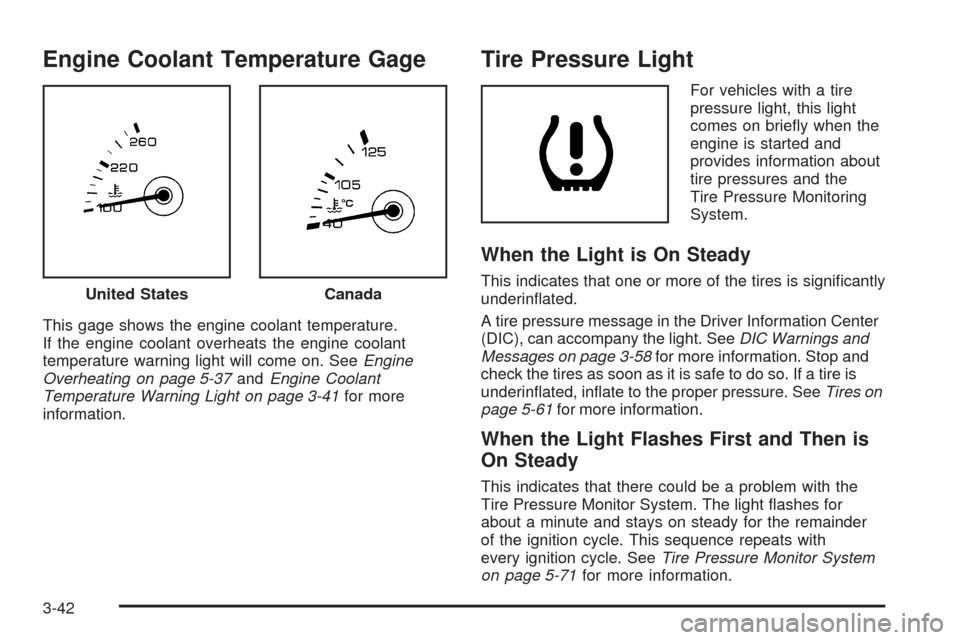
Engine Coolant Temperature Gage
This gage shows the engine coolant temperature.
If the engine coolant overheats the engine coolant
temperature warning light will come on. SeeEngine
Overheating on page 5-37andEngine Coolant
Temperature Warning Light on page 3-41for more
information.
Tire Pressure Light
For vehicles with a tire
pressure light, this light
comes on brie�y when the
engine is started and
provides information about
tire pressures and the
Tire Pressure Monitoring
System.
When the Light is On Steady
This indicates that one or more of the tires is signi�cantly
underin�ated.
A tire pressure message in the Driver Information Center
(DIC), can accompany the light. SeeDIC Warnings and
Messages on page 3-58for more information. Stop and
check the tires as soon as it is safe to do so. If a tire is
underin�ated, in�ate to the proper pressure. SeeTires on
page 5-61for more information.
When the Light Flashes First and Then is
On Steady
This indicates that there could be a problem with the
Tire Pressure Monitor System. The light �ashes for
about a minute and stays on steady for the remainder
of the ignition cycle. This sequence repeats with
every ignition cycle. SeeTire Pressure Monitor System
on page 5-71for more information. United States
Canada
3-42
Page 203 of 490
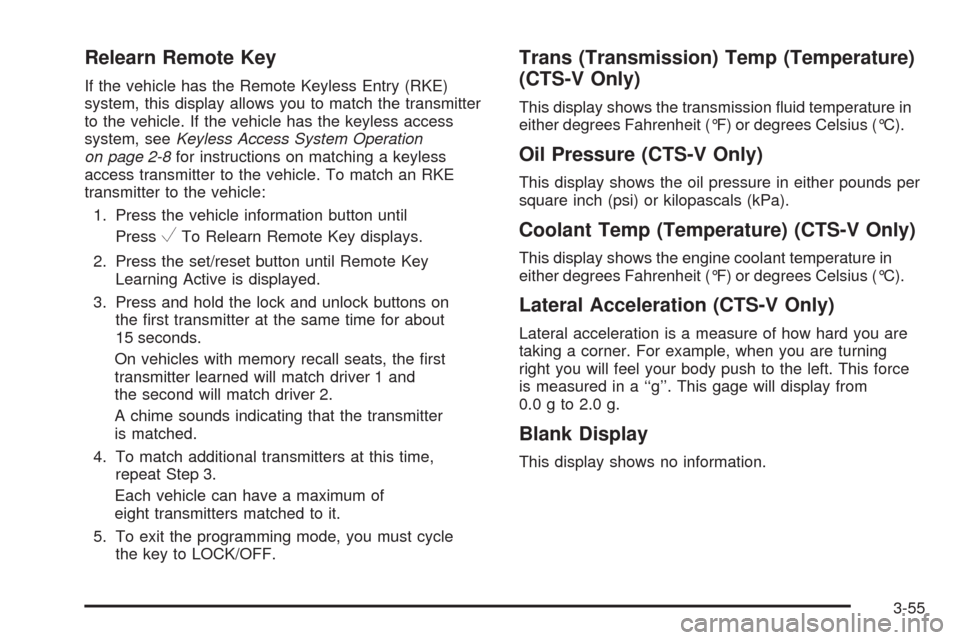
Relearn Remote Key
If the vehicle has the Remote Keyless Entry (RKE)
system, this display allows you to match the transmitter
to the vehicle. If the vehicle has the keyless access
system, seeKeyless Access System Operation
on page 2-8for instructions on matching a keyless
access transmitter to the vehicle. To match an RKE
transmitter to the vehicle:
1. Press the vehicle information button until
Press
VTo Relearn Remote Key displays.
2. Press the set/reset button until Remote Key
Learning Active is displayed.
3. Press and hold the lock and unlock buttons on
the �rst transmitter at the same time for about
15 seconds.
On vehicles with memory recall seats, the �rst
transmitter learned will match driver 1 and
the second will match driver 2.
A chime sounds indicating that the transmitter
is matched.
4. To match additional transmitters at this time,
repeat Step 3.
Each vehicle can have a maximum of
eight transmitters matched to it.
5. To exit the programming mode, you must cycle
the key to LOCK/OFF.
Trans (Transmission) Temp (Temperature)
(CTS-V Only)
This display shows the transmission �uid temperature in
either degrees Fahrenheit (°F) or degrees Celsius (°C).
Oil Pressure (CTS-V Only)
This display shows the oil pressure in either pounds per
square inch (psi) or kilopascals (kPa).
Coolant Temp (Temperature) (CTS-V Only)
This display shows the engine coolant temperature in
either degrees Fahrenheit (°F) or degrees Celsius (°C).
Lateral Acceleration (CTS-V Only)
Lateral acceleration is a measure of how hard you are
taking a corner. For example, when you are turning
right you will feel your body push to the left. This force
is measured in a ‘‘g’’. This gage will display from
0.0 g to 2.0 g.
Blank Display
This display shows no information.
3-55
Page 210 of 490
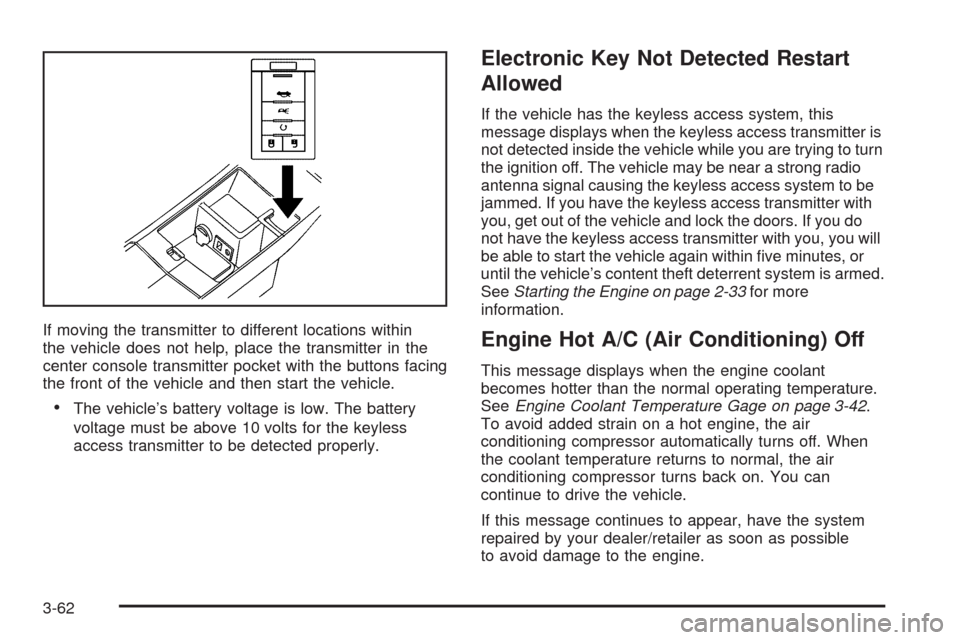
If moving the transmitter to different locations within
the vehicle does not help, place the transmitter in the
center console transmitter pocket with the buttons facing
the front of the vehicle and then start the vehicle.
The vehicle’s battery voltage is low. The battery
voltage must be above 10 volts for the keyless
access transmitter to be detected properly.
Electronic Key Not Detected Restart
Allowed
If the vehicle has the keyless access system, this
message displays when the keyless access transmitter is
not detected inside the vehicle while you are trying to turn
the ignition off. The vehicle may be near a strong radio
antenna signal causing the keyless access system to be
jammed. If you have the keyless access transmitter with
you, get out of the vehicle and lock the doors. If you do
not have the keyless access transmitter with you, you will
be able to start the vehicle again within �ve minutes, or
until the vehicle’s content theft deterrent system is armed.
SeeStarting the Engine on page 2-33for more
information.
Engine Hot A/C (Air Conditioning) Off
This message displays when the engine coolant
becomes hotter than the normal operating temperature.
SeeEngine Coolant Temperature Gage on page 3-42.
To avoid added strain on a hot engine, the air
conditioning compressor automatically turns off. When
the coolant temperature returns to normal, the air
conditioning compressor turns back on. You can
continue to drive the vehicle.
If this message continues to appear, have the system
repaired by your dealer/retailer as soon as possible
to avoid damage to the engine.
3-62
Page 211 of 490
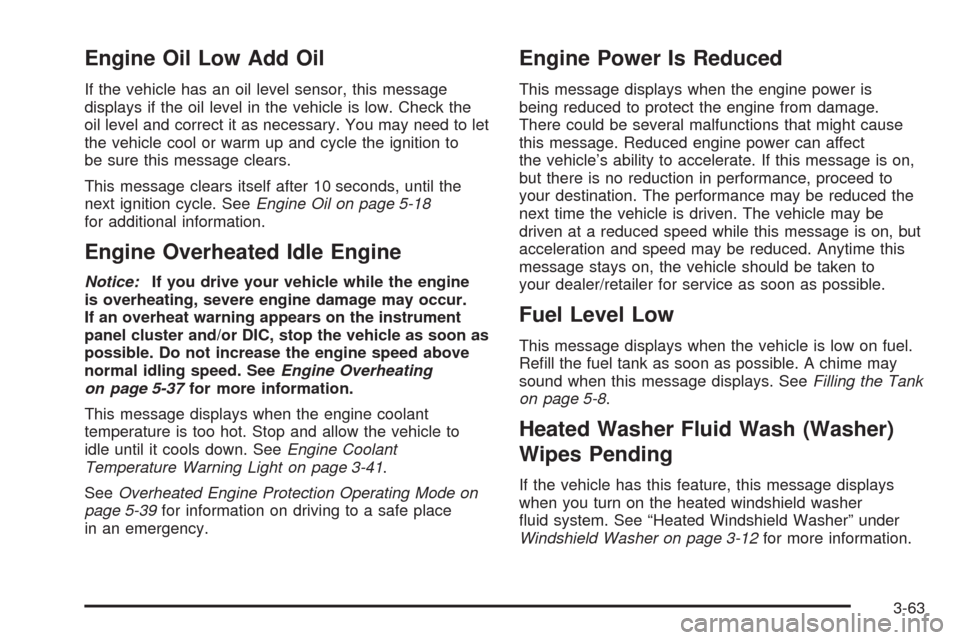
Engine Oil Low Add Oil
If the vehicle has an oil level sensor, this message
displays if the oil level in the vehicle is low. Check the
oil level and correct it as necessary. You may need to let
the vehicle cool or warm up and cycle the ignition to
be sure this message clears.
This message clears itself after 10 seconds, until the
next ignition cycle. SeeEngine Oil on page 5-18
for additional information.
Engine Overheated Idle Engine
Notice:If you drive your vehicle while the engine
is overheating, severe engine damage may occur.
If an overheat warning appears on the instrument
panel cluster and/or DIC, stop the vehicle as soon as
possible. Do not increase the engine speed above
normal idling speed. SeeEngine Overheating
on page 5-37for more information.
This message displays when the engine coolant
temperature is too hot. Stop and allow the vehicle to
idle until it cools down. SeeEngine Coolant
Temperature Warning Light on page 3-41.
SeeOverheated Engine Protection Operating Mode on
page 5-39for information on driving to a safe place
in an emergency.
Engine Power Is Reduced
This message displays when the engine power is
being reduced to protect the engine from damage.
There could be several malfunctions that might cause
this message. Reduced engine power can affect
the vehicle’s ability to accelerate. If this message is on,
but there is no reduction in performance, proceed to
your destination. The performance may be reduced the
next time the vehicle is driven. The vehicle may be
driven at a reduced speed while this message is on, but
acceleration and speed may be reduced. Anytime this
message stays on, the vehicle should be taken to
your dealer/retailer for service as soon as possible.
Fuel Level Low
This message displays when the vehicle is low on fuel.
Re�ll the fuel tank as soon as possible. A chime may
sound when this message displays. SeeFilling the Tank
on page 5-8.
Heated Washer Fluid Wash (Washer)
Wipes Pending
If the vehicle has this feature, this message displays
when you turn on the heated windshield washer
�uid system. See “Heated Windshield Washer” under
Windshield Washer on page 3-12for more information.
3-63